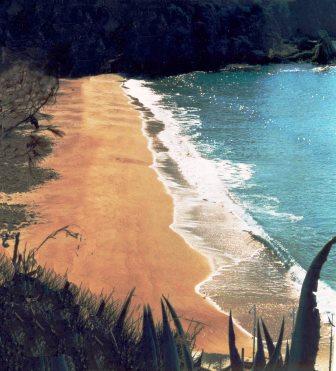Nature has indicated Livatho as place of unforgetable experiences. For centuries it was the centre of Kefallonia because the first capital of the island –until 1757- was the Castle of Saint George. The thing that remains deeply carved into the memory of the visitor is today the breathtaking view from the hill of the Castle and the sightseeing in it, the blissfulness of the magnificent villages and the emerland beaches of Livatho.
The region of Ano (Upper) Livatho combines mountain and sea whereas serenity and nobility prevail in Kato (Lower) Livatho. The residents of Livatho started travelling very early. As a result there was a fleet of 300 ships expanding a large commercial network at the Mediterranean Sea as well as at the Black Sea.
Livatho is a place full of life, cultural and social activities. Numerous festivals and festivities cover all seasons, especially the summer.
BEACHES
LOURDAS: Long, sandy beach with running waters, vegetable and orange-tree gardens, olive-trees as well as tropical plants make this beach unique in Greece.
TRAPEZAKI: Don’t forget to visit the small church on the picturesque hill before the sandy, tranquil beach.
AVITHOS: It considered as the best beach in Livatho. This beach is sandy and well-organised with shallow clear waters appropriate even for surfing.
AGIOS-HELIS (Saint Achilleus): Small, orginised beach of grey-coloured sand near Svoronata. It’s worth swimming there eventhough there are many steps.
AGIOS THOMAS: Both, sandy and rocky beach at Karavados. On descending to the beach, drink fresh spring “Karavisianiko” water.
PALIOLINOS: A small beach sometimes with sand, sometimes full of pebbles, past Korianna – Klismata area.
AMMES: Organised sandy beach at Svoronata with the typical crystal clear sea, very common in Livatho area.
KLIMATSIAS: Sandy beach near Spartia for swimming and serenity.
AGIA PELAGIA: The homonymous cape and beach between Agios Helis and Ammes.
LITHERO: A quiet beach within a small distance from Lourdas for all those who like enjoying calm swimming and sunbathing moments.
PESSADA: Beach and small fishing port from where during the summer period there is everyday sea transportation to Zante.
GETTING AROUND LIVATHO – PLACES OF INTEREST
THE CASTLE OF SAINT GEORGE: The old capital of the island housing the Venetian Governor until 1757. It was built before the Byzantine times and was renovated by the Venetians. Visit the internal part of the Castle as well as the Church of Evangelistria, a medieval building with a magnificent belfry. Actually, the one-κλίτοςstep basilica is a museum that contains valuable exhibits of unique icons from several, now ruined, churches of the area. Ascend the hill which overhangs Livatho and you will be rewarded lavishly.
MAZARAKATA: It is worth visiting the Mycenaean tombs -16 post-Mycenaean curved tombs with 83 burials and one vaulted tomb-. The excavation finds are exhibited in the Archaelogical Museum in Argostoli. Also, 55 important excavation finds are kept in Nechatel, the birthplace of the Military Governor of Kefallonia de Bosset who made the excavations (1810-1812).
BUZANTINE MUSEUM: This museum is within the Convent of Saint Andreas of Milapidia. There are many rare exhibits from the 13th c. such as icons, woodcuts, wall paintings.
SISSIA MONASTERY: According to the tradition the monastery was built in the 13th c. by Saint Francisco of Assizi. It was destroyed by the earthquake of 1953. Today it has been rebuilt and the holly icon of Our Lady of Stefano Tzancarolo –c. 1700- is kept in the Historical and Folklore Museum in Argostoli.
THE MONASTERY OF CHRIST ON THE CROSS: The homonymous icon is kept at the Evangelistria Chucrh in Pessada and the holly icon of Our Lady Diotissa –Our Lady of Vlachernes- is kept in the monastery.
DIAS (ZEUS) ISLET – CHRUCH OF OUR LADY DIOTISSA: The islet may be visited by boat as it is not far away from the shore. One hundred steps lead to a 24 m. altitude where is the church built on the ruins of an temple dedicated to Zeus. Near this islet there is a smaller one named Danisti or Myzithris.
KALLIGATA: In the 18th c. chuerch admire the beautifull baroque wooden curved iconostatis and the impressive belfry.
KERAMIES: This is the village of the national benefactors Vallianos and of the shipowning Likiardopoulos family. The russian rhythm church of Saint Vassilios is of important value.
KOURKOUMELATA: Jewel village. Buildings of fine architecture, modern village planning and elegant gardens compose an idyllic environment and therefore the village is considered the most beautiful in Balkans. It was totally destroyed by the 1953 earthquake and it was reconstructed thanks to the donation of Vergotis family. Saint Gerasimos church is of important value.
LAKYTHRA: This village is streched on the homonymous hill. The view is panoramic. In excavations near the church of Saint Nikolaos came to light four post-Myceanean tombs (1250-1150 b.C.). Their finds are exhibited in the Archaeological Museum in Argostoli. In the village is the Rock of Lord Byron, a place used by the famous noble Englishman while composing his poets.
METAXATA: Old Episcopal see of Kefallonia. Archbishop Nikodemos Metaxas (1628-1646) was the man whose name was connected with the important event of the establishing in Kefallonia of the first printing house in the East. In addition, Lord Byron stayed at the house of the doctor of Ali-Pasha, Stravolemos Metaxas, for four months before travelling to Messolonghi. This house and the bust of the famous philellenist poet are in the central square of the village.
DOMATA: You may visit the church of the Presentation of the Virgin Mary with its fine gold-plated iconostasis made in 1839 from the melting of 12.000 pounds. In the church there is kept the coffin of the hanged by the Turks bishop Gregorios IV. The coffin was saved and brought at Domata in 1821 by the Kefallonian captain George Sclavos.
SVORONATA: Rich village with Kefallonian architecture houses and iron gates samples of the old art of the Kefallonian blacksmiths.
Evridiki Livada

